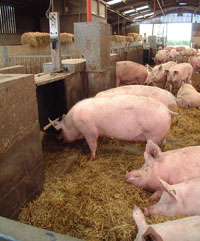Prevent pig infertility this summer

Pig producers shouldn’t underestimate the effect heat stress can have on breeding performance, especially when up to 90% of variation for traits like litter size are not from an additive genetic source.
It can be easy blaming poor performance on genetics, but if producers are unprepared for periods of high temperatures, resulting fertility problems can last for many weeks, says JSR’s Grant Walling.
“With the production of mature sperm taking eight weeks, boars can be affected for this length of time after the initial period of heat stress. So it’s imperative boars are kept in adequately ventilated facilities and have access to plenty of water,” he says.
Sperm numbers and sperm quality decreases at times of peak temperature, so Dr Walling recommends assessing all semen through a microscope before it is used.
“Look out for abnormalities such as bent and deformed tails, proximal and distal droplets or low motility scores. The semen provided by the boar has to be at its best to achieve optimum performance figures.”
But the cool transportation and storage of semen is just as important to successful breeding as the condition of the sperm, says Mr Walling.
“Any movement of ±2 C from 17C will cause the semen to deteriorate. Sperm temperature must remain consistent until insemination and any sperm taken out of cool boxes and left in warm temperatures can become irreversibly damaged.”
Heat stress also affects sow fertility, says Dr Walling. “The success of a first service is often determined by the condition of the sow after weaning. But during high temperatures access to clean, plentiful water with a flow rate of 2- 2.5 litres/min is also essential.”
For indoor producers cooling and ventilation systems should be closely monitored. Sows should also be adequately fed during this period.
“Feeding sows ad libitum in the farrowing house or increasing to three times a day can improve the farrowing rate. Feed intakes will be suppressed by high temperatures or poor availability of water, so it’s a balancing act and one that is vital to get right. For some producers increased servings to compensate for a lower farrowing rate may also be a sensible option.”

